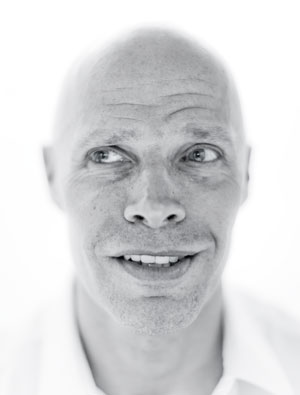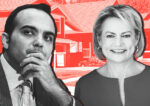Trending
The Closing: Keith Rubenstein (VIDEO)
The Somerset founder on being "Superman," dropping $400K on a bunny and dealing with critics in the Bronx

Keith Rubenstein is a founder of real estate investment firm Somerset Partners, which has acquired more than $2 billion worth of office and multifamily property nationwide since launching in 2000. In the mid-aughts, Somerset earned a reputation for betting big on its Manhattan properties. In 2005, it paid $294 million for an office building at 85 Tenth Avenue, which it sold for $430 million two years later. It followed that with the 2007 purchase of 450 Park Avenue, an office tower, for $509 million — a record at $1,583 per foot. Somerset sold the building in 2014 to Oxford Properties Group for $575 million. More recently, the company has made headlines for a mega development in the South Bronx, where it and a partner the Chetrit Group plan to build as many as six residential towers.
DOB: July 23, 1964
Lives in: Manhattan
Family: Married to second wife Inga Rubenstein for 16 years; 3 children
Where did you grow up?
Highland Park, N.J. My father was a doctor, the guy that actually carried a black bag and made house calls. My mom was a housewife.
What were you like as a kid?
My whole focus in life was sports. My earliest memory, when I was 4, is watching the ’69-’70 Knicks play in the championship against the Lakers. I played basketball, baseball and football. I wasn’t the most physically gifted, but I was dedicated and tenacious.
How did you end up in real estate?
I was pre-med at Syracuse. But I realized in order to be a doctor, you have to really want to be … and you can’t have an aversion to blood, which I do. After graduating with a biology degree, I sold cars for a year and decided to go to law school [at Widener University in Delaware]. I practiced landlord-tenant law and learned the real estate business from the inside.
You’ve been very successful over the years, but you’ve had tough moments as well, like when your law career ended in disbarment in 2008. What have you learned from that difficult experience and how did it help shape your career?
My feeling is that every experience can be an opportunity for positive growth. So I believe that when you make a mistake, you acknowledge it, you learn from it and you move on. I think that’s helped me handle adversity and I think it’s made me better at the work I’m focused on now. It’s part of a broader lesson that was probably the best advice I’ve ever gotten: Look at the person before the deal. I know who I am, and I know what I’ve learned and accomplished. That’s what informs my commitment to my firm and my family and everyone I’ve worked with.

Keith Rubenstein (Photo: Studio Scrivo)
How did you transition to development?
I looked at a lot of real estate opportunities as an attorney. One day I decided that I wanted to try to play monopoly. A mutual friend introduced me to Somerset’s two other co-founders. The idea was they had operational experience, and I had legal knowledge and access to some investor capital.
When you bought 450 Park, you paid a record price. Are you drawn to risk?
If there is a risk that’s worth being taken, we’ll take it. We paid a record price [at 450 Park], but we also sold it for a record price. It wasn’t a whimsical buy. We had a plan for this building and felt there was tremendous value in the retail.
What are your passions outside of work?
We’re art collectors, but my No. 1 passion is health and fitness. I gave up drinking two years ago. Everyone has woken up with hangovers and I decided I didn’t want that feeling anymore.
Was there a piece of art that was particularly exciting to get your hands on?
It’s about the collection, not a particular piece. [But] one of the most fun things I bought was a giant, 12-foot-tall bunny by the artist KAWS. We were at a Leonardo DiCaprio Foundation event in Santa Fe when we saw it. We bought it for $400,000 or thereabouts. I don’t think there’s a day I’ve looked at it that it didn’t make me smile.
What’s your workout of choice?
I lift weights. I do deadlifts of 380 pounds. [I’m not] Superman, but for a 52-year-old real estate guy, it’s not bad. My favorite cardio is jump rope. I jump for an hour [at my home gym] until I can’t jump anymore. I’m not the guy who needs a trainer to make me do anything. When I had a trainer, I made my trainer do what I did. It became competitive.
You and your wife throw some A-list parties that have landed on Page Six more than once.
Inga throws an incredible Russian New Year’s party with tons of caviar, vodka and food. I joke that when guests areleaving, I’m waking up. A few years ago, a friend who’s a well-known soccer player and I were having a good time drinking vodka. I showed him the gym and he challenged me to a pull-up contest. I did 21. Then he gets up. He starts slowing down at 15 but squeaks out 22 and then stops. The moral is you never go first.
You bought your Upper East Side townhouse for $35 million in 2007 and are now asking $84.5 million. Are you shooting high?
I look at it as a one-of-a-kind oil painting, as opposed to some new luxury development with lines of apartments that are identical. It’s a high price but it’s justifiably priced.
That home and the South Bronx are worlds apart. Is it hard to bounce between the two?
That’s what makes New York unique. It doesn’t work if you build everything like a Beaux Arts townhouse on the Upper East Side or an affordable housing [apartment] in one of the boroughs.
You took heat for a star-studded party at your Bronx development when critics misinterpreted the theme to be the “Bronx is burning.” Was that fair?
We’ve learned a lot. Some of the things we never thought about in the past we’re thinking about now. The most important thing is community interaction. We think we’re bringing a lot of good to a neighborhood that’s been extremely underutilized.
What keeps you up at night?
Not much. If I have something that’s bothering me, I’ll deal with it tomorrow.




